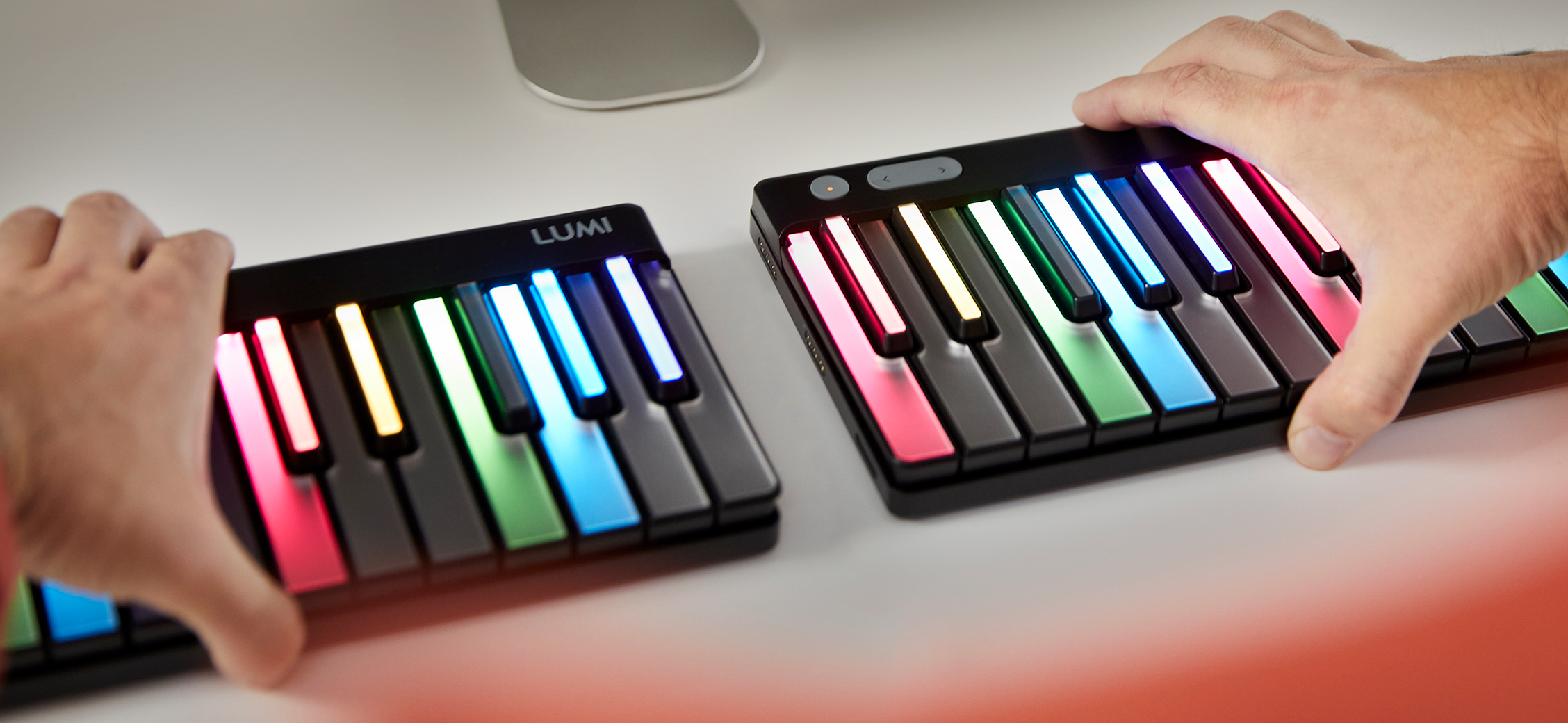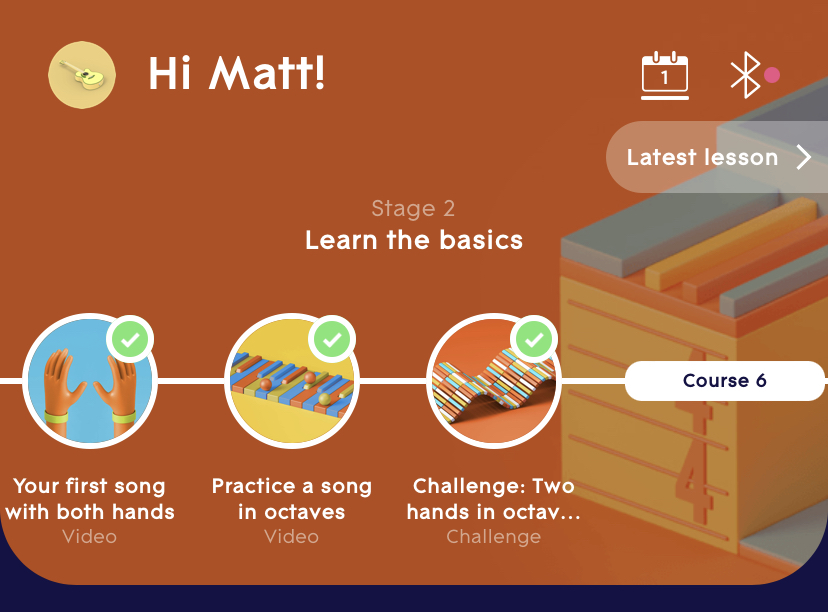Learning piano hand coordination with Piano M
Your piano journey with ROLI Learn is filled with milestones bringing you closer to mastering the art of piano playing, and one such milestone is mastering the skill of two-handed playing.
So, you’ve been learning with the vibrant, 24-note ROLI Piano M for a while now. You’ve put in those recommended 10 minutes each and every day to build up the fundamentals of being a piano player. That consistent practice has made you feel more comfortable, and naturally, you're excited for what comes next.
As this happens, the notes which once felt overwhelming are starting to feel not only manageable, but maybe a bit condensed. Most electric keyboards are larger, but none of them are this portable or teach dynamically with illuminated keys.
When practicing, you're tempted to add in your second hand with more space between the notes, and overall explore a wider octave range. While the two arrow buttons on the top-left of Piano M allow for changing the octave, it’s more about needing to play in a wider range simultaneously.

Benefits of playing with two Piano Ms
The individual Piano M instrument is plenty powerful to build comfort in your first playing hand, which is often the right hand. Though past the basic exercises with two hands, your goals in learning through the app and beyond will eventually benefit from 48 notes in front of you at a time rather than 24.
A wider octave range is perhaps the most obvious benefit. This enables the music you play to be more rich and full as you develop skills in hand independence. What’s a bit more subtle of a benefit relates back to how we built this moment of growth into the instrument itself.
Have you ever noticed those small metal pins on each side of the keysboard? These are DNA-connectors, which allow you to snap together multiple keys and increase your octave range.
The ROLI Learn App supports playing with two Piano Ms snapped together at once, opening up more complex song arrangements and fundamentals exercises. If you wanted to, you could actually snap up to four of them together at the same time and play piano with even more notes than a grand!
Besides the fun alone, having 3-4 Piano Ms is most relevant for those looking to use the instrument with computer-based applications.

The pivotal moments in piano learning
Piano learning, like any instrument, comes with its pivotal moments. These call for celebration, but no doubt require a lot of practice and discipline to break through. Some milestones to look forward to include memorizing the circle of fifths, improvising on a keyboard, sight read sheet music, writing your first song and performing in public.
Before all of that, however, there is the milestone of playing with two hands comfortably and confidently. This is what makes the piano one of the most magical instruments; the best piano players can create an illusion of two musicians playing at once.
Today, you might be able to learn a left hand part, or a right hand part, but combining them dynamically is a milestone we approach much more slowly. By dynamic, we mean the ability to play softly or loudly to express yourself through a song, as well as master rhythms of a higher difficulty.
First two-hands piano exercises in the ROLI Learn App
Using the ROLI Learn app's learning stages allow you to progress as you feel most comfortable. Each Stage, of which there are 6, includes a wide range of lessons bucketed into digestible courses. You can repeat any of these lessons for as long as it takes to become comfortable with a fundamental or even commit a basic song to memory.
Though it isn’t until Stage 2 in which we get the chance to try out playing songs with two hands. Specifically Lessons 5-7 at the end of Course 5 shown here:

From here, you’ll encounter more regular two-handed lessons as the goal will be to gradually build your coordination. These practice sessions will certainly feel awkward at first, but stick with it! Some of our absolute favorite exercises with two hands come a good while later in Stage 3, Course 6, lessons 2-6. They are worth waiting for!
Before you know it, you’ll notice progress.
Building comfort in each playing hand
Strong coordination playing with both hands together begins with strong coordination playing with each hand individually.
Hand independence isn't something to force, but rather taken slow, and each exercise is built to help you get there. Take the "Challenge" at the end of Stage 4, Course 3 as an example. This chord progression for the right hand includes a repetitive, but challenging rhythm to maintain while making complex chord changes.

Outside of the course material, learning songs is another way to practice. Take the Quick Play version of "Stand By Me" as an example. Learning the primary melody of this song does not require two hands or a second Piano M, but if you were to want to level up into more complex arrangements, this is where your second instrument will pave the roadway of your learning.


You might notice the notes look different above. That’s because this take of "Stand By Me" was practiced with the Rainbow notation. You can think of it as the second level as you move towards traditional sheet music, we’ve gone into this in more depth for you here.
Two hands in unison
The baby steps continue. With this in mind, jumping right into complex patterns mixed together would be skipping a fundamental part of body control and technique. That fundamental is playing in unison, or both of your hands playing the same rhythm and melodic direction.
This video is a great start with this, as it walks through the super simple C major scale. This tends to be the first scale we learn on piano because it only uses the white keys.
In this exercise, both hands are playing simple octaves of each other, but the ways the fingers stay in position are different. For this reason, there are three key ways to practice this: left hand alone, right hand alone, and both.
Why "splitting" our hands can be difficult
Unless you’re an octopus, this is not something which comes particularly easy to any of us. The ability to play with two hands independently – remember, this is meaning at different rhythm, loudness (also called dynamics) and style at the same time – is something that makes piano very unique to learn.
YouTuber Jazer Lee helps us take the baby steps, including an exercise you don’t even need your piano for. A look through this video will give you a sense of what lies ahead, and how you can add extra exercises into your routine.
Any drummers you know should be very familiar with this learning curve, as they have to "split" not only their hands but their feet as well.
Contrary Motion
In beginning to split your hands, the act of contrary motion will be an early challenge. Believe it or not, this is actually the first lesson on the ROLI Learn app where we begin to play with two hands – so we really mean early!
This method involves playing the same rhythm with your hands, but one hand will be ascending when the other is descending. When music expresses itself this way, it can make for some very interesting harmonies as the notes move closer and further away from one another.
Interested in the different kinds of motion in music? See here.
Graduating to intermediate playing
When you've reached this point in your learning journey and you’re feeling more and more comfortable with 48 keys in front of you, we’ll be the first to say you no longer need to call yourself a beginner! Arriving here means that you’ve mastered a number of fundamentals which will unlock more dynamic, beautiful and unexpected pieces of music.
What you can look forward to is branching even further out from different types of motions, and into different types of rhythms. These have their own name: polyrhythm. If you’re really eager to dig into this topic, you can find it explained in further detail for more advanced levels here.
Before you know it, you’ll be hearing some of your favorite piano songs and thinking you can not only play them in a "Quick Play" version like on the ROLI Learn app, but fully as performed by the artist. For me, that’s become "Lost Forever" by Tony Njoku, though I expect to need a few more lessons before then!
Join the ROLI community